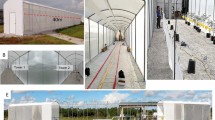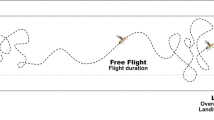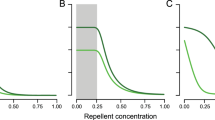Abstract
THE behaviour of flying insects which make use of airborne chemicals in their search for food, oviposition sites or sexual partners can be separated into two phases, the search flight bringing them into contact with the attractant plume and the approach flight leading them to its source1,2. The second phase is characterised by upwind orientation in response to the appropriate chemical stimuli3–6. Mosquitoes are known to fly upwind as they approach a warm-blooded host7–9. For most insects relatively little is known of the pattern of the preceding search flight which Haskell2 described as ‘wandering’, but where the wind is light it may be upwind1. Experiments in West Africa have shown that the majority of mosquitoes entered flight traps from the downwind side, that is they appeared to have been flying upwind, regardless of the presence or absence of a host (ref. 10 and W. F. Snow, unpublished). Here we report experiments that unexpectedly provide evidence for the opposite type of behaviour.
This is a preview of subscription content, access via your institution
Access options
Subscribe to this journal
Receive 51 print issues and online access
$199.00 per year
only $3.90 per issue
Buy this article
- Purchase on Springer Link
- Instant access to full article PDF
Prices may be subject to local taxes which are calculated during checkout
Similar content being viewed by others
References
Steiner, G., Naturwissenshaften, 40, 514–515 (1953).
Haskell, P. T., Symp. R. ent. Soc. Lond., 3, 29–45 (1966).
Schwinck, I., 10th Int. Cong. Ent. Montreal, 1956, 2, 577–582 (1958).
Kellogg, F. E., Frizel, D. E., and Wright, R. H., Can. Ent., 94, 884–888 (1962).
Farkas, S. R., and Shorey, H. H., Science, 178, 67–68 (1972).
Kennedy, J. S., and Marsh, D., Science, 184, 999–1001 (1974).
Bertram, D. S., and McGregor, I. A., Bull. ent. Res., 47, 669–681 (1956).
Hocking, B., Bull. Wld Hlth Org., 29 (supplement), 121–126 (1963).
Dow, R. P., and Morris, C. D., J. med. Ent., 9, 60–66 (1972).
Gillies, M. T., and Wilkes, T. J., Bull. ent. Res., 59, 441–456 (1969).
Gillies, M. T., and Wilkes, T. J., Bull. ent. Res., 60, 225–235 (1970).
Lewis, T., and Dibley, G. C., Ann. appl. Biol., 66, 477–484 (1970).
Author information
Authors and Affiliations
Rights and permissions
About this article
Cite this article
GILLIES, M., WILKES, T. Evidence for downwind flights by host-seeking mosquitoes. Nature 252, 388–389 (1974). https://doi.org/10.1038/252388b0
Received:
Issue Date:
DOI: https://doi.org/10.1038/252388b0
This article is cited by
-
Modelling and observing the role of wind in Anopheles population dynamics around a reservoir
Malaria Journal (2018)
-
Visualization of house-entry behaviour of malaria mosquitoes
Malaria Journal (2016)
-
Roles and challenges of construction firms and public health entomologists in ending indoor malaria transmission in African setting
Malaria Journal (2016)
-
Wind direction and proximity to larval sites determines malaria risk in Kilifi District in Kenya
Nature Communications (2012)
-
Navigational Strategies Used by Insects to Find Distant, Wind-Borne Sources of Odor
Journal of Chemical Ecology (2008)
Comments
By submitting a comment you agree to abide by our Terms and Community Guidelines. If you find something abusive or that does not comply with our terms or guidelines please flag it as inappropriate.



